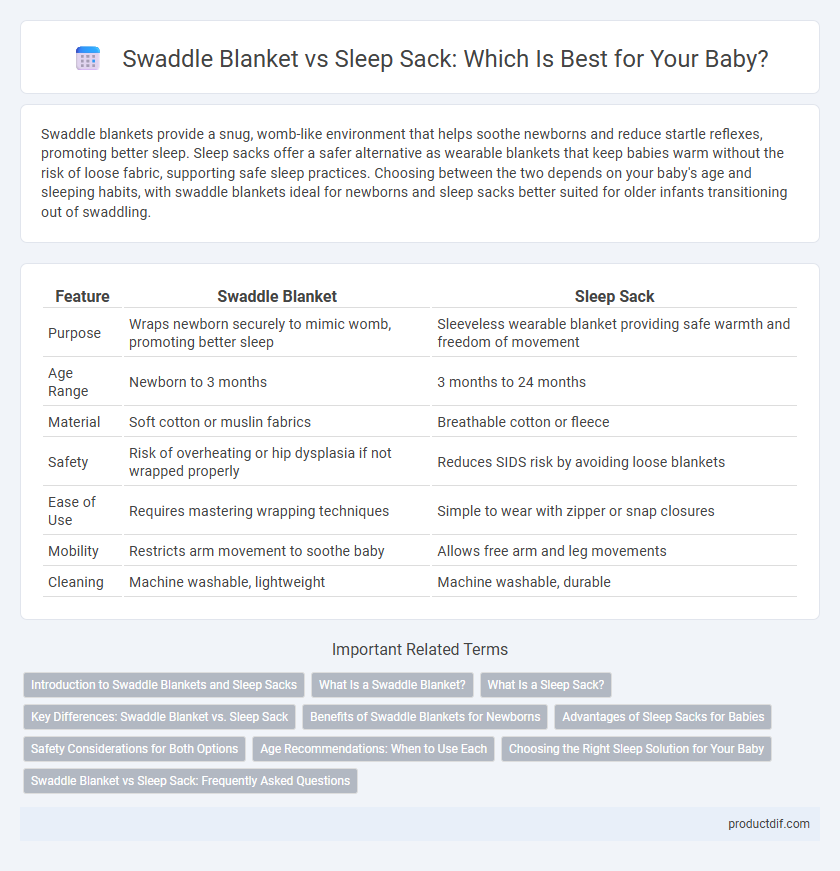Swaddle blankets provide a snug, womb-like environment that helps soothe newborns and reduce startle reflexes, promoting better sleep. Sleep sacks offer a safer alternative as wearable blankets that keep babies warm without the risk of loose fabric, supporting safe sleep practices. Choosing between the two depends on your baby's age and sleeping habits, with swaddle blankets ideal for newborns and sleep sacks better suited for older infants transitioning out of swaddling.
Table of Comparison
| Feature | Swaddle Blanket | Sleep Sack |
|---|---|---|
| Purpose | Wraps newborn securely to mimic womb, promoting better sleep | Sleeveless wearable blanket providing safe warmth and freedom of movement |
| Age Range | Newborn to 3 months | 3 months to 24 months |
| Material | Soft cotton or muslin fabrics | Breathable cotton or fleece |
| Safety | Risk of overheating or hip dysplasia if not wrapped properly | Reduces SIDS risk by avoiding loose blankets |
| Ease of Use | Requires mastering wrapping techniques | Simple to wear with zipper or snap closures |
| Mobility | Restricts arm movement to soothe baby | Allows free arm and leg movements |
| Cleaning | Machine washable, lightweight | Machine washable, durable |
Introduction to Swaddle Blankets and Sleep Sacks
Swaddle blankets are versatile, breathable fabrics designed to securely wrap a baby, mimicking the womb's snug environment for improved sleep and reduced startle reflex. Sleep sacks, also known as wearable blankets, provide a safer alternative to loose bedding by offering warmth without the risk of suffocation, featuring wearable designs with zip or snap closures. Both products support safe sleep guidelines by promoting comfort and security, catering to different stages of infant development.
What Is a Swaddle Blanket?
A swaddle blanket is a soft, breathable fabric designed to wrap snugly around a newborn, mimicking the womb's comforting environment to promote better sleep and reduce startle reflex. Typically made from cotton or muslin, it allows for secure wrapping while maintaining airflow to prevent overheating. Swaddle blankets offer flexibility in wrapping techniques, making them essential for soothing infants during early sleep stages.
What Is a Sleep Sack?
A sleep sack is a wearable blanket designed to keep babies warm and safe during sleep without the risk of loose bedding. Unlike traditional swaddle blankets, it eliminates the need for wrapping by featuring a sleeveless, zippered design that allows for easy movement while maintaining comfort. Sleep sacks promote safe sleep practices by reducing the risk of suffocation and overheating, making them a preferred choice for both parents and pediatricians.
Key Differences: Swaddle Blanket vs. Sleep Sack
Swaddle blankets provide snug wrapping to limit a baby's movement and mimic the womb environment, promoting better sleep and reducing startle reflexes. Sleep sacks function as wearable blankets that allow more freedom of movement while keeping the baby warm and safe, often equipped with armholes or sleeves. Unlike swaddle blankets, sleep sacks are designed for older infants who can roll over, prioritizing safety without restricting mobility.
Benefits of Swaddle Blankets for Newborns
Swaddle blankets provide newborns with a snug, womb-like environment that promotes better sleep by reducing the startle reflex and calming their nervous system. These blankets are breathable and soft, ensuring comfort and preventing overheating, which supports safer sleep. Their adjustable design allows for easy swaddling, enhancing soothing and helping babies feel secure during the crucial early months.
Advantages of Sleep Sacks for Babies
Sleep sacks provide a safer alternative to traditional blankets by reducing the risk of suffocation and Sudden Infant Death Syndrome (SIDS), ensuring a secure sleeping environment for babies. Unlike swaddle blankets that restrict movement, sleep sacks allow natural arm movement, promoting healthy motor development and comfort. Their wearable design maintains consistent warmth, preventing loose bedding hazards and enhancing overall sleep quality for infants.
Safety Considerations for Both Options
Swaddle blankets and sleep sacks both prioritize infant safety by reducing the risk of SIDS through proper fit and breathable fabrics. Swaddle blankets require careful wrapping to avoid hip dysplasia and ensure the baby can breathe freely, while sleep sacks offer a wearable design that prevents loose bedding hazards. Choosing between them depends on age-appropriate usage and adherence to safe sleep guidelines recommended by pediatric experts.
Age Recommendations: When to Use Each
Swaddle blankets are ideal for newborns up to 3 months old, providing snug comfort that mimics the womb and helps regulate their sleep patterns. Sleep sacks are recommended for babies older than 3 months who have started to roll over, offering a safer, wearable blanket option that reduces the risk of suffocation. Choosing the right product based on age ensures optimal safety and comfort during sleep.
Choosing the Right Sleep Solution for Your Baby
Swaddle blankets offer snug warmth mimicking the womb, promoting better sleep for newborns who still enjoy restricted movement. Sleep sacks provide a safe, wearable blanket that reduces the risk of loose bedding hazards and accommodate growing babies transitioning out of swaddles. Choosing the right sleep solution depends on your baby's age, developmental stage, and preference for freedom of movement during sleep.
Swaddle Blanket vs Sleep Sack: Frequently Asked Questions
Swaddle blankets and sleep sacks are essential baby products designed to improve infant sleep safety and comfort, with swaddle blankets providing a snug wrap that mimics the womb and sleep sacks offering a wearable blanket that prevents startle reflex disruptions. Parents often ask about the age range suitability, with swaddle blankets typically recommended for newborns up to 3-4 months, while sleep sacks can be used for infants up to 12 months or older, promoting independent sleeping as the baby grows. Safety considerations include ensuring the swaddle blanket is snug but not too tight to avoid hip dysplasia, and choosing sleep sacks with appropriate TOG ratings to regulate temperature and reduce the risk of overheating.
Swaddle blanket vs sleep sack Infographic

 productdif.com
productdif.com